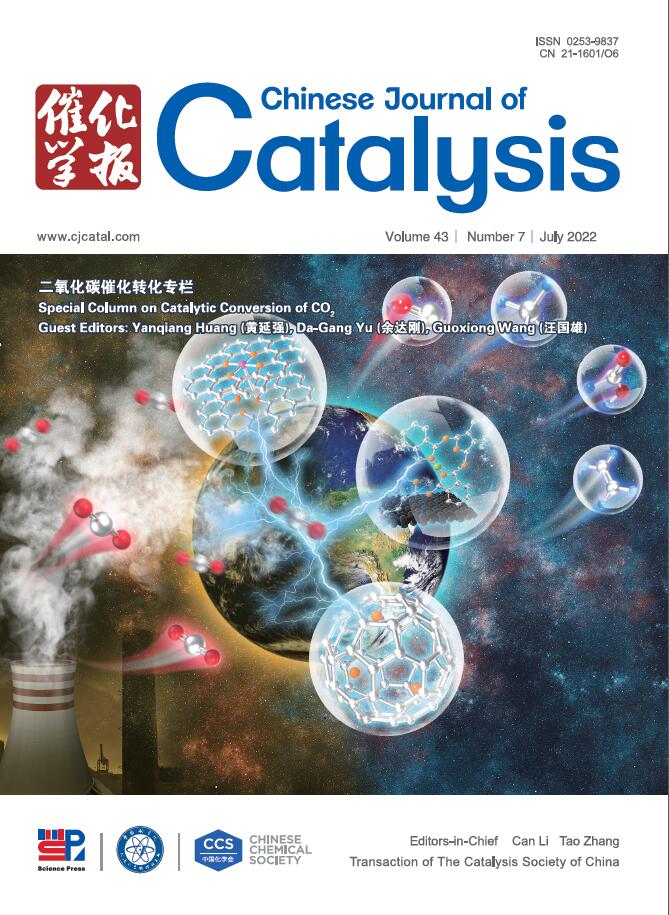MXene衍生的MoS2/TiO2/Ti3C2纳米线上乳酸光重整同时制氢
IF 15.7
1区 化学
Q1 CHEMISTRY, APPLIED
引用次数: 0
摘要
开发高效的光催化剂来解决协同能源和环境危机仍然面临着重大挑战。在本报告中,我们提出了一种高效的mxene基光催化剂,该催化剂通过水热处理与MoS2纳米贴片和TiO2/Ti3C2 (TTC)纳米线结合。在所有测试的复合材料中,优化后的光催化剂产生了显著的H2和旋转聚乳酸(PLA)成丙酮酸(PA)。在紫外可见(λ≥365 nm)光照射下,TEOA和PLA作为牺牲试剂存在,H2的析出速率分别为637.1和243.2 μmol g−1 h−1。光催化活性的提高是由于TTC光催化剂表面双助催化剂的结合,为同时生成PA和生成H2创造了理想的协同效应。MoS2TiO2/Ti3C2 (MTT)复合材料可以产生更多的光激发载流子,从而产生更多的活性自由基,从而提高体系的光催化活性。这项工作旨在展示其未来的意义,并指导科学界通过光催化更有效地将H2商业化。本文章由计算机程序翻译,如有差异,请以英文原文为准。
Simultaneous hydrogen production with photo reforming of lactic acid over MXene derived MoS2/TiO2/Ti3C2 nanowires
Developing efficient photocatalysts to address collaborative energy and environmental crises still faces significant challenges. In this report, we present a highly efficient MXene–based photocatalyst, which is combined with MoS2 nano patches and TiO2/Ti3C2 (TTC) nanowires through hydrothermal treatment. Of all the composites tested, the optimized photocatalyst gave a remarkable H2 and revolving polylactic acid (PLA) into pyruvic acid (PA). Achieving a remarkable H2 evolution rate of 637.1 and 243.2 μmol g−1 h−1, in the presence of TEOA and PLA as a sacrificial reagent under UV-vis (λ ≥ 365 nm) light irradiation. The improved photocatalytic activity is a result of the combination of dual cocatalyst on the surface of TTC photocatalyst, which create an ideal synergistic effect for the generation of PA and the production of H2 simultaneously. The MoS2TiO2/Ti3C2 (MTT) composite can generate more photoexcited charge carriers, leading to the generation of more active radicals, which may enhance the system's photocatalytic activity. This work aims at demonstrating its future significance and guide the scientific community towards a more efficient approach to commercializing H2 through photocatalysis.
求助全文
通过发布文献求助,成功后即可免费获取论文全文。
去求助
来源期刊

Chinese Journal of Catalysis
工程技术-工程:化工
CiteScore
25.80
自引率
10.30%
发文量
235
审稿时长
1.2 months
期刊介绍:
The journal covers a broad scope, encompassing new trends in catalysis for applications in energy production, environmental protection, and the preparation of materials, petroleum chemicals, and fine chemicals. It explores the scientific foundation for preparing and activating catalysts of commercial interest, emphasizing representative models.The focus includes spectroscopic methods for structural characterization, especially in situ techniques, as well as new theoretical methods with practical impact in catalysis and catalytic reactions.The journal delves into the relationship between homogeneous and heterogeneous catalysis and includes theoretical studies on the structure and reactivity of catalysts.Additionally, contributions on photocatalysis, biocatalysis, surface science, and catalysis-related chemical kinetics are welcomed.
 求助内容:
求助内容: 应助结果提醒方式:
应助结果提醒方式:


